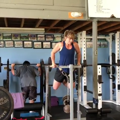Tendon Strength
5 Proven Ways To Increase Tendon Strength
Do you ever just sit and think about the human body and how wild it is. There is your skin essentially holding all of these things in place. Your organs, the fluids in your body, your bones and your muscles are all kept intact by your skin. But let's dig deeper. What about your muscle, how does your bicep stay where it is and not weirdly end up floating down around your ankle trying to take the place of the soleus (that would be weird and wild, wouldn't it?). Well, you can thank your tendons for that. In fact, you can thank your tendons for a whole heck of a lot of other things. And because of everything your tendons do for you, you might also want to pause for a moment to think about how to make sure your tendons are strong and healthy. Let's unpack why your tendons, or should we call them “body cables” are important and how you can ensure you are strengthening them inside your training.

What are tendons?
Body cables. That's what they are. Your skin holds everything in but your tendons- those bad boys hold your muscles on to your bones. Do you like the fact that your tricep stays on the back of your arm and bicep on the front? You can thank your tendons for that.
Your tendons are fibrous connective tissues that connect muscle to bone. They are made of collagen fibers arranged in parallel bundles. Your muscle creates a force and your tendons take the force from the muscle to the bone to generate movement. Without tendons, muscle contractions wouldn’t produce any movement.

While muscles often get the spotlight in training, strong tendons are a critical part of performance, stability, and injury prevention. Talking specifically about performance and stability, strong tendons are responsible for transmitting force. Yes, they get your bones to move from the contractions of the muscle but the stronger the tendon is the more efficiently it can handle different amounts of force and eventually transfer that force. This aids in reducing energy loss and enhancing both power and resiliency during movement. Preventing injury is always a priority for an athlete, wouldn't you agree? With stronger tendons, you can better withstand high loads and repetitive strain which is commonly seen in sports, and ultimately this helps reduce the risk of injuries like tendinitis or even tendon tears.
How to Strengthen Them
Tendons are unlike muscles in that the adaptation process takes a lot longer. Training them requires patience, precision, and a slightly different approach than what you would do when trying to strengthen a muscle. Here are the 5 key components of strengthening tendons.
Progressive Overload
You know the adaptation process takes a bit longer for tendons when it comes to getting them and keeping them strong. But training with the idea of progressive overload in mind is true for both muscle strengthening as well as tendon strengthening.
Progressive overload is simply gradually increasing the amount of stress on the part being trained. Whether it's tendons or muscles, you want to avoid jumping directly into quick weight or rep increases in order to minimize the risk of overuse injuries like tendinitis. Focusing on slow, controlled movements in order to control the loading of the tendon itself can help ensure proper adaptation occurs.
For example, consider starting with lower weights and higher reps in compound movements like the traditional deadlift or a squat. As adaptation occurs and you become stronger and notice the favorable changes occurring, then start to consider adding more weight, reps, sets or even a slower tempo.

Isometric Holds
Holding a position without movement is work. It can be fatiguing, a test of mental capacity and most of all, a real doozy for giving your tendons a heck of a workout. Isometric holds are exactly that- holding a position without movement. The position is in an engaged one though, you arent getting to the bottom of a squat and dumping it, rather you are holding tension at whichever angle you pause in. This helps tendons adapt to sustained tension and strengthens the tendons at specific and different joint angles. Ultimately this approach can help reduce pain in overuse injuries found with tendons specifically. Incorporating holds 2-3 times a week is ideal.
The well known wall sit or plank are some examples of an isometric hold. But getting creative with holding positions such as a lunge in the bottom position, a bicep curl holding at the 90 degree position, and even bench pressing but holding 2 inches above your chest are different ways to challenge the isometric position.
Eccentric Training
We already touched on isometric holds which are static movements, therefore it's a category all on its own. But with the dynamic movements, there are two main phases- the concentric and the eccentric. A concentric movement is the shortening of a muscle while the eccentric phase is the lengthening of the muscle. Adding eccentric specific training to your programming can be beneficial because it places high stress on tendons. That high stress is also beneficial for stimulating collagen. Both of these things make tendons more durable and less prone to injury.
Incorporating tempo work into training is a great way to add eccentric load and ultimately strengthen the tendons. Instead of simply squatting, can you take a 4 second down approach. Rather than ripping through the bench press you have programmed, instead can you focus on a 3 second lower, maybe even add a spicy pause right above the chest and then complete the rep? Even a pull-up negative—where you start at the top of the bar and lower yourself more slowly than in a standard pull-up—offers a powerful form of eccentric training that strengthens the tendons in all the involved joints

The most important thing to remember when adding eccentric training, no matter what the exercise is, go slow. Remember, adaptation takes time and you want progressive overload, not aggressive overload. So start lighter than you think in order to avoid excess and, quite honestly, unnecessary soreness as your tendons adapt.
Plyometrics and Jumping
Your tendons are elastic. They store and release energy during movement, supporting the explosive power needed in activities like sprinting and jumping. Adding in things like plyometrics and other jumping exercises help enhance the elastic properties of the tendon itself. This makes the tendon more efficient and effective at that energy transfer.
As with everything else related to strengthening tendons and adding in some of these protocols, when considering adding in plyometrics and jumping, starting slow is incredibly important. Starting with 3-5 reps per set and prioritizing quality movement over rep after rep can help avoid tension overload.
Begin with simpler plyometric movements, such as ankle hops, jump rope, or low box step-offs, then progress to box jumps and lateral bounds, and eventually incorporate advanced exercises like depth jumps and single-leg bounding to ensure continuous overload.

Nutrition + Recovery
Your next workout is only as good as your current recovery protocol. Recovering is essential especially when considering tendon health. Overworking tendons without sufficient recovery can lead to chronic injuries. Bringing recovery back to the basics is a great starting place. Making sure you are taking adequate rest days in order to avoid repetitive strain is important. Proper programming can help with this. And if you are struggling with this, more specifically our peak strength app can take the guesswork out of this for you.
Adding in foam rolling to get blood flow to sore or worked areas can be helpful. Always prioritizing adequate sleep is a huge component in recovery. Sleep is always important but when talking about sleep in regards to what it does for tendon health, sleep is where the tendon literally repairs itself from training. Capitalize there when you can.
Nutrition plays a significant role in tendon health as well. Staying adequately hydrated directly impacts tendon health. In order to build strong tendons, you need them to be healthy. When it comes to diet there are supplements you can take and nutrients to prioritize but the simplest thing to do is to stay well hydrated. Being dehydrated can make tendons stiffer and more prone to injuries while being well hydrated supports overall recovery by promoting tissue repair and reducing inflammation. Staying hydrated also lubricates joints to some degree. Your tendons love and appreciate that.
As for foods and supplements, prioritizing collagen rich foods like bone broth supports tendon repair. Always prioritizing protein as an athlete is important, shooting for a simple goal of 1g of protein per pound you weigh. And even eating foods rich in omega 3s like fish and seeds can help reduce overall inflammation.

Conclusion
Real strength isn’t just about big muscles or hitting top speeds—it’s about all the little things that hold your body together. Tendons play a huge part in keeping you strong, healthy, and ready for action. If you pay attention to them and include tendon-focused work in your routine, you’ll build a body that can handle the long haul, not just the next workout.


Gaylemarie Kayes
Gaylemarie, but just call her GM, is a seasoned fitness and nutrition professional with nearly two decades of experience in the industry. With a diverse clientele ranging from ultra runners to high-level competitors, gm brings a wealth of knowledge and expertise. As a former high-level athlete in running, CrossFit and Olympic lifting to now, a busy yet active mother, she understands the challenges of balancing fitness and goal getting with a hectic lifestyle. Gm's approach emphasizes discipline, ownership, and hard work, tailored to honor each individual's life season for optimal health and well-being.
Blog Topics

Yo, It's Dane
Welcome to the Garage Strength Blog, where it is my goal to provide you with the experience and knowledge I've gained in the strength and conditioning world over many years of learning from both successes and failures. I train elite-level athletes in a multitude of sports from the high school to professional levels, already producing 5 Olympics and 30+ National Champions. If you want to be the next champion I train, check out my strength programs below!
Start Training With Me

Join for free educational videos EVERY WEEK on strength coaching and athletic performance

